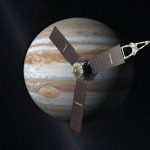Jupiter is humongous


Dave Mosher From Business Insider
You’d be right to doubt whether or not Jupiter actually orbits the sun, or if you could survive the planet’s sickening radiation belt, but make no mistake about its size.
At more than 89,000 miles in diameter and about 318 times more massive than Earth — within the ballpark of being a failed star — Jupiter is absolutely humongous.
NASA’s 4-ton, basketball court-size Juno spacecraft reached the gas giant on July 4, 2016.
But that’s long after the Cassini space probe briefly visited Jupiter in 2001, on its way to Saturn.
To understand just how big the former world really is, gaze at this Cassini photo of Jupiter’s hellish, sulfur-spewing moon Io cast against the planet’s clouds:
Io is roughly the size of Earth’s moon and orbits above Jupiter at roughly the same distance, as NASA explains at its July 7, 2016, Astronomy Picture of the Day.
Still not grasping that?
Here’s Io, the yellow-covered moon that’s pockmarked with hundreds of volcanoes, set next to Earth and its moon:
Jupiter’s size makes it a terribly difficult place to explore, since its strong gravity corrals and accelerates the belches of Io’s volcanoes into high-speed particles and radiation.
This is also why Juno’s mission should prove revolutionary: Few spacecraft have gotten or will ever get as close to Jupiter.
During its jam-packed year-long mission, the probe will dive through the planet’s clouds, “taste” the radiation belts, take photos, record beautiful polar auroras, and round up clues that might reveal what Jupiter’s core is made of — and if it’s solid at its core.
But the science Juno can pull off will be limited.
The reason is because the probe lacks a radioisotope power source, or nuclear battery, like the ones on Cassini, Galileo, Voyager, and other spacecraft that came before this latest Jovian mission.
Instead of generating electricity using red-hot plutonium-238, which is extremely limited in supply (despite production kicking off for the first time since the end of the Cold War), Juno relies on three sensitive, bus-size solar panels. To avoid destroying them with radiation, Juno has to perform some extreme acrobatics during its visit.
After Juno finishes exploring the gargantuan planet, its fate will not be pretty.
To protect any aliens that might be living on icy moons such as Europa and Ganymede, NASA intends to fly the $1 billion probe to its doom — right into the seemingly bottomless, noxious clouds of Jupiter.
IMAGES:
IMAGE: jupiter io moon sizes nasa cassini PIA02879 Cassini Imaging Team/SSI/JPL/ESA/NASA
juno jupiter nasa
An illustration of the Juno spacecraft around Jupiter. NASA
moon io earth size comparison nasa jpl ua gregory revera Gregory H. Revera/NASA/JPL/University of Arizona
For more on this story go to: http://www.businessinsider.com/size-of-jupiter-juno-mission-2016-8?utm_source=feedburner&%3Butm_medium=referral&utm_medium=feed&utm_campaign=Feed%3A+businessinsider+%28Business+Insider%29







